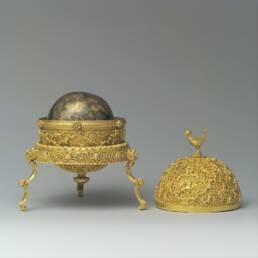Nestled in the Vindhya ranges of Central India lies Mandu, an ancient city that is today famous for its palaces and tragic love stories. Interestingly, Mandu also has a hidden treasure that may have its roots somewhere in Africa.
The central Indian town is steeped in history. While its palaces and monuments tell stories of its former glories and its famous poet Queen Roopmati, its streets tell a very different one – one of a fruit locally called Mandu ki Imli/Mandu’s tamarind.
White in color and sour in taste, people from the world over come seeking the fruit that has a peculiar history. Also known as the Khorasani tamarind, the fruit Is not native to the land. It is a culmination of trade and migrations for over a thousand years.
The tree which bears the fruit is locally called the ghost tree, the seeds of which is believed to have been brought to Mandu from central Asia by spice traders who exchanged the seeds with other items.
Historians, however, claim that the seeds came to Central Asia from East Africa where the tree bears a very different name, the Tree of Life. Scientifically called the Adansonia digitata and commonly known as the baobab, it is one of the most ancient trees in the world.
Origins of the baobab are hard to trace. While some historians claim that it originated in West Africa, others believe that it was part of the massive continent Gondwanaland which once housed the Indian sub-continent, Australia, and parts of East Africa like Madagascar.
The tree’s earliest recorded mention was by the 14th-century Moroccan traveler Ibn-Batuta and the name may have an Arabic origin “bu hibab,” meaning “many-seeded fruit.
In the mid-18th century, French botanist Michel Adanson observed the tree on the island of Sor in Senegal and wrote a meticulously detailed botanical description of the tree with illustrations. The baobabs are known for their ability to hold massive amounts of water.
And it is probably because of their many traits that its seeds become a hot item for export over the centuries, making their way to Australia, the Malaya peninsula, and even the sub-continent.
Though the baobabs are a rare sight, their deciduous nature and broad and fluted trunk make them easy to spot. The Portuguese are believed to have brought the baobabs in the 16th century on the western coast, after which they might have spread across the country.
The baobabs can be spotted across many cities – Mumbai has a large number of it, a baobab tree in the Golconda fort in Hyderabad is estimated to be more than 430 years old and is the oldest living Baobab outside of Africa.
The Baobab in some cultures is seen as a healer and in others as a bad omen. Whatever the case, these trees which have today spread their roots across various continents hold an intriguing shared history.
Source:
- To Mandu, from Madagascar by Raul Dias, https://www.thehindubusinessline.com/blink/cover/the-baobab-tree-madagascars-gift-to-mandu/article27609709.ece
Image attribute:
- Mandu ki Imli, from @WikiCommons




